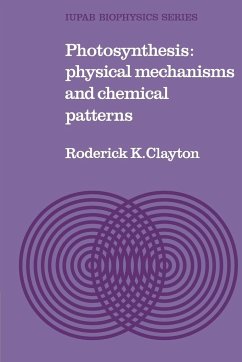Life on earth depends on the photosynthetic use of solar energy by plants, and efforts to develop alternative sources of energy include a major thrust toward the use of photosynthesis to yield fuels. The study of photosynthesis is an especially convincing way of bringing together the disciplines of physics, chemistry, and biology and can be a valuable element in the teaching of biophysics and biochemistry. This book provides the only detailed modern treatment of the subject in a concise form. Part I outlines the historical development of the subject, emphasizing the chemical nature of photosynthesis and the roles of chlorophylls and other pigments. Part II reviews our present knowledge of the structure and components of photosynthetic tissues in relation to their function. Part III deals with the photo-chemistry of photosynthesis and with the patterns of chemical events, principally electron and proton transfer, that follow the photo-chemistry. Part IV treats the relationships of electron and proton transport to ATP formation, and the metabolic patterns of carbon assimilation. An epilogue exposes major areas of confusion and ignorance and indicates potentially fruitful directions of research, including the development of photosynthetic systems for solar energy conversion. Throughout the book, there are frequent digressions into those aspects of optics and molecular physics relevant to the subject matter. Suitable for upper undergraduate and graduate course use, this book is also sufficiently detailed to give professional scientists a perspective of the subject at the level of contemporary research.
Table of contents:
Foreword; Preface; Part I. Research in Photosynthesis: Basic Developments to About 1960: 1. The chemical nature of photosynthesis; 2. The roles of chlorophylls and other pigments; 3. The cooperation of two quanta or two photosystems in photosynthesis; 4. Major digression: molecular physics and spectroscopy; quantum energy and redox energy; measurements involving light; Part II. Pigment-Protein Complexes in Photosynthetic Membranes: Their Compositions, Structures, and Functions: 5. Components of the photosynthetic membranes of bacteria: composition and function in energy transfer and photochemistry; 6. Photosynthetic membranes of plants: components and their molecular organization; energy transfer and its regulation; 7. Measurements with polarized light: interactions of molecules in excited states; orientations of pigments in photosynthetic tissues; Part III. Photochemical Charge Separation, Secondary Transport of Electrons and Protons, and Oxygen Evolution: 8. Reaction centers: photochemical charge separation and interaction with nearest electron donors and acceptors; 9. Oxygen evolution; secondary transport of electrons and protons; Part IV. The Formation of ATP and the Assimilation of Carbon Dioxide: 10. Electrochemical gradients and the formation of ATP; 11. Carbon assimilation by plants; Epilogue; Notes; Index.
Hinweis: Dieser Artikel kann nur an eine deutsche Lieferadresse ausgeliefert werden.
Table of contents:
Foreword; Preface; Part I. Research in Photosynthesis: Basic Developments to About 1960: 1. The chemical nature of photosynthesis; 2. The roles of chlorophylls and other pigments; 3. The cooperation of two quanta or two photosystems in photosynthesis; 4. Major digression: molecular physics and spectroscopy; quantum energy and redox energy; measurements involving light; Part II. Pigment-Protein Complexes in Photosynthetic Membranes: Their Compositions, Structures, and Functions: 5. Components of the photosynthetic membranes of bacteria: composition and function in energy transfer and photochemistry; 6. Photosynthetic membranes of plants: components and their molecular organization; energy transfer and its regulation; 7. Measurements with polarized light: interactions of molecules in excited states; orientations of pigments in photosynthetic tissues; Part III. Photochemical Charge Separation, Secondary Transport of Electrons and Protons, and Oxygen Evolution: 8. Reaction centers: photochemical charge separation and interaction with nearest electron donors and acceptors; 9. Oxygen evolution; secondary transport of electrons and protons; Part IV. The Formation of ATP and the Assimilation of Carbon Dioxide: 10. Electrochemical gradients and the formation of ATP; 11. Carbon assimilation by plants; Epilogue; Notes; Index.
Hinweis: Dieser Artikel kann nur an eine deutsche Lieferadresse ausgeliefert werden.








